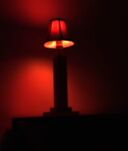
Electric light plays a key role in the film, often signaling the presence of the supernatural, as in other David Lynch works such as Eraserhead, Twin Peaks, and the unproduced Ronnie Rocket.
The Red Lamp[]
A lamp with a red shade, in a storage/office room in Sue and Smithy's house, plays a prominent symbolic role in the film. When Sue is first seen entering the room, the lamp dims to show her a glimpse of Billy, then shorts out completely and presages the first appearance of the Valley Girls.

When Sue goes to Krimp's backyard, he approaches her ominously with a translucent red lightbulb in his mouth, which gives her a mental flash of the red lamp.

Another lamp with a red shade appears when the old Polish men hold a séance to summon the Lost Girl. The lamp is seemingly the only electric light in the room. In this scene, Franciszek says (in Polish), "It was red..." In the following scene, the Polish men turn into Rabbits, and Suzie repeats: "It was red." During this Rabbits scene, a reflection appears in the Rabbits' window that resembles the shade on Sue's lamp, and is focused on in closeup at the end of the scene.
Yet another red-shaded lamp appears behind Sue when she sits down in the Forty Deuce club.
In More Things That Happened (the deleted scenes), Sue says that she still has the lamp with her when living with her sister, keeping it by her bed. “It’s that same damn lamp’s always been with me,” she says, adding that she doesn’t go anywhere without it. She says the lamp is from her mom’s side of the family. Her mother changed it to the red shade; it used to have a shade with a floral print, which Sue has only seen in a black and white photo.
Blue Light[]

When Nikki/Sue enters the "Axxon N." door, a single flash of blue light seems to transport her back in time.
After the red lamp shorts out, a blue lightbulb lights up, signaling the first appearance of the Valley Girls.

After Nikki kills the Phantom, a bright blue light signals the Lost Girl's freedom. Shortly thereafter, Nikki enters the Rabbits' home and sees a blue light: it comes from a film projector, which may be projecting her image.
Flashlights[]
A flashlight effect highlights the Valley Girls one by one as they speak when Sue first sees them.

A flashlight effect highlights Sue as she runs toward camera, seemingly representing her descent into madness.
A flashlight effect highlights Smithy when he beats Sue.
Other Appearances[]

The very first shot of the movie is a film projector.
A lamp scene during the opening Axxon N. sequence appears throughout the film as a reflection on the TV in Lost Girl's hotel room, even though the lamp itself no longer seems to be physically present in the room.
A distinctive lamp is present in Sue and Smithy's bedroom.
A flashing light effect seems to transport Sue from her living room to Hollywood Boulevard, where she is now a prostitute.
More Things That Happened (Deleted Scenes)[]
A light goes on in Nikki's house above a door. She opens the door and inside is a dark hallway with a red light at the end. As she walks down the hallway, there are flashes of light (and possibly a close-up shot of a film projector seen from the front) which transport Sue to her front yard, but she does not recognize the street or her house as she re-enters. It seems that she temporarily becomes Nikki again, as the scene transitions to Nikki in her mansion (she is then transported briefly to Poland, where she sees some very bright white lights).
Lanni uses a flashlight to "shoot" at Sandi's toy flying saucer.
Sue sits still in her living room as day turns into night. Bright lights outside the house flash, eventually containing colors and images of the Valley Girls dancing.
Trivia[]
- A red lamp was also a prominent motif in David Lynch's prior film, Mulholland Drive.
- David Lynch plays Bucky J, a lighting tech.
- When Krzysztof Majchrzak (the Phantom) arrived to shoot the "Krimp" scene, he wore a pair of glasses that Lynch hated. Majchrzak insisted that he needed a prop. Lynch went to his cupboard and found a little piece of broken tile, a rock and the red lightbulb. He gave Majchrzak his choice between the three items, and Majchrzak chose the bulb. (Source: Catching the Big Fish, David Lynch, 2006, Penguin Group, p. 140-41.)
